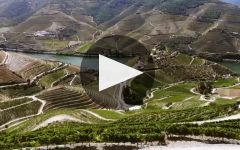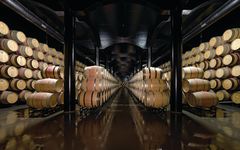Quinta do Crasto Douro Superior Red 2013
-
Wine
Spectator -
Wine &
Spirits -
Wine
Enthusiast




Product Details
Your Rating
Somm Note
Winemaker Notes
Professional Ratings
-
Wine Spectator
Very plush, with concentrated dark plum, Asian spice and dark currant flavors that are creamy and rich-tasting. Medium-grained tannins on the long finish are filled with dark chocolate and black licorice notes. Better than previously reviewed. Drink now through 2020.
-
Wine & Spirits
Grown at Crasto’s Quinta da Cabreira in the Douro Superior, this purple-black wine requires a lot of air to unwind from a tight and tannic place to a more relaxed floral and juicy taste. At first, it’s a little gamey, a generous red with lamby notes. A day later, the wine is clean, spicy, the flavors open and racing through the finish.
-
Wine Enthusiast
Coming from the Roquette family's newly acquired vineyards in the Douro Superior, this wine shows the great synergy between the region and the new wave of table wines. It has a smooth richness with ripe tannins and concentrated black fruits and rich wood-aging flavors. The wine is still at its fruity stage, so although it is drinkable now, it will be better from 2017.
Other Vintages
2019-
Wine
Spectator
-
James
Suckling -
Robert
Parker
-
Wine
Spectator -
Robert
Parker
-
Wine
Enthusiast
-
Wine
Spectator
-
Wine
Spectator








Nestled on a privileged location in the Douro, Quinta do Crasto is one of the oldest winemaking estates in the region – the name ‘Crasto’ is derived from the Latin word ‘castrum’, which means ‘Roman fort’. The first known references to Quinta do Crasto can be traced back to 1615, long before the Douro became the world’s first Demarcated Wine Region in 1756. In the early 1900s, Quinta do Crasto was purchased by Constantino de Almeida, the founder of the famous Constantino Port house. Today, his granddaughter, Leonor Roquette, and her husband Jorge Roquette own and manage the estate, together with their sons, Miguel and Tomás. The Roquette family has invested tremendous time, attention, and resources to rebuild and expand the vineyards and facilities to produce top quality Port and Douro table wines. Vineyard mapping, DNA-matched replanting, a new state-of-the-art wine cellar and centuries of tradition mean that no detail in the winemaking and vineyard management is overlooked.
Quinta do Crasto produces different styles of port and table wines each year. Together with their winemakers and their entire team, they seek to produce year after year wines that display the unique and beautiful characteristics of the Douro, through a tireless devotion to tradition, integrity and excellence.

With hundreds of red grape varieties to choose from, winemakers have the freedom to create a virtually endless assortment of blended red wines. In many European regions, strict laws are in place determining the set of varieties that may be used, but in the New World, experimentation is permitted and encouraged resulting in a wide variety of red wine styles. Blending can be utilized to enhance balance or create complexity, lending different layers of flavors and aromas. For example, a red wine blend variety that creates a fruity and full-bodied wine would do well combined with one that is naturally high in acidity and tannins. Sometimes small amounts of a particular variety are added to boost color or aromatics. Blending can take place before or after fermentation, with the latter, more popular option giving more control to the winemaker over the final qualities of the wine.
How to Serve Red Wine
A common piece of advice is to serve red wine at “room temperature,” but this suggestion is imprecise. After all, room temperature in January is likely to be quite different than in August, even considering the possible effect of central heating and air conditioning systems. The proper temperature to aim for is 55° F to 60° F for lighter-bodied reds and 60° F to 65° F for fuller-bodied wines.
How Long Does Red Wine Last?
Once opened and re-corked, a bottle stored in a cool, dark environment (like your fridge) will stay fresh and nicely drinkable for a day or two. There are products available that can extend that period by a couple of days. As for unopened bottles, optimal storage means keeping them on their sides in a moderately humid environment at about 57° F. Red wines stored in this manner will stay good – and possibly improve – for anywhere from one year to multiple decades. Assessing how long to hold on to a bottle is a complicated science. If you are planning long-term storage of your reds, seek the advice of a wine professional.

The home of Port—perhaps the most internationally acclaimed beverage—the Douro region of Portugal is one of the world’s oldest delimited wine regions, established in 1756. The vineyards of the Douro, set on the slopes surrounding the Douro River (known as the Duero in Spain), are incredibly steep, necessitating the use of terracing and thus, manual vineyard management as well as harvesting. The Douro's best sites, rare outcroppings of Cambrian schist, are reserved for vineyards that yield high quality Port.
While more than 100 indigenous varieties are approved for wine production in the Douro, there are five primary grapes that make up most Port and the region's excellent, though less known, red table wines. Touriga Nacional is the finest of these, prized for its deep color, tannins and floral aromatics. Tinta Roriz (Spain's Tempranillo) adds bright acidity and red fruit flavors. Touriga Franca shows great persistence of fruit and Tinta Barroca helps round out the blend with its supple texture. Tinta Cão, a fine but low-yielding variety, is now rarely planted but still highly valued for its ability to produce excellent, complex wines.
White wines, generally crisp, mineral-driven blends of Arinto, Viosinho, Gouveio, Malvasia Fina and an assortment of other rare but local varieties, are produced in small quantities but worth noting.
With hot summers and cool, wet winters, the Duoro has a maritime climate.
